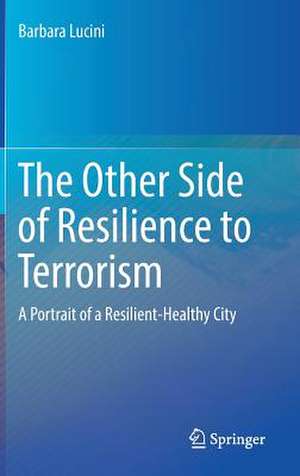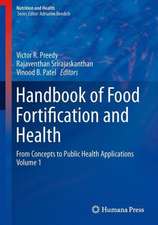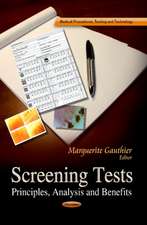The Other Side of Resilience to Terrorism: A Portrait of a Resilient-Healthy City
Autor Barbara Lucinien Limba Engleză Hardback – 17 oct 2017
- Summary of sociological theories of terrorism
- The Resilience D model for assessing and managing urban terrorist activity
- Findings on resilience and vulnerabilities of terror groups
- Photo-illustrated analysis of neighborhoods in Milan, describing areas of risk and resilience
- Virtual ethnography with perspectives from native residents, recent immigrants, and security experts
- Proposals for coordinated communications between resource agencies
| Toate formatele și edițiile | Preț | Express |
|---|---|---|
| Paperback (1) | 655.57 lei 38-44 zile | |
| Springer International Publishing – 22 aug 2018 | 655.57 lei 38-44 zile | |
| Hardback (1) | 718.10 lei 6-8 săpt. | |
| Springer International Publishing – 17 oct 2017 | 718.10 lei 6-8 săpt. |
Preț: 718.10 lei
Preț vechi: 755.88 lei
-5% Nou
Puncte Express: 1077
Preț estimativ în valută:
137.41€ • 143.83$ • 114.37£
137.41€ • 143.83$ • 114.37£
Carte tipărită la comandă
Livrare economică 31 martie-14 aprilie
Preluare comenzi: 021 569.72.76
Specificații
ISBN-13: 9783319569420
ISBN-10: 3319569422
Pagini: 194
Ilustrații: XVII, 192 p. 211 illus., 35 illus. in color.
Dimensiuni: 155 x 235 x 20 mm
Greutate: 0.48 kg
Ediția:1st ed. 2017
Editura: Springer International Publishing
Colecția Springer
Locul publicării:Cham, Switzerland
ISBN-10: 3319569422
Pagini: 194
Ilustrații: XVII, 192 p. 211 illus., 35 illus. in color.
Dimensiuni: 155 x 235 x 20 mm
Greutate: 0.48 kg
Ediția:1st ed. 2017
Editura: Springer International Publishing
Colecția Springer
Locul publicării:Cham, Switzerland
Cuprins
The Other Side of Resilience.- The theoretical relationships among security, resilience, migration, and terrorism.- A portrait of a resilient–healthy city: urban resilience, migration, and terrorism threats.- The theoretical and methodological implications of terrorism and urban resilience.- Milan city: a journey through the traces and signs of the other side of resilience.- The portrait: Centro storico.- The portrait: Stazione centrale, Gorla, Turro, Greco, Crescenzago.- The portrait: Città Studi, Lambrate, Venezia.- The portrait: Vittoria, Forlanini.- The portrait: Vigentino, Chiaravalle, Gratosoglio.- The portrait: Barona, Lorenteggio.- The portrait: Baggio, De Angeli, San Siro.- The portrait: Fiera, Gallaratese, Quarto Oggiaro.- The portrait: Stazione Garibaldi, Niguarda.- A theoretical and methodological proposal for the future of counterterrorism and urban resilience.
Notă biografică
Barbara Lucini, PhD, is adjunct professor of Risk Management and Crisis Communication at Catholic University of Sacred Heart in Milan, Italy. As part of the Department of Sociology, she teaches courses in public policies. She also is a teaching assistant in sociology and risk communication, crisis management, and theory and techniques of mass communications, and a lecturer on crisis, disaster, and resilience topics at universities, secondary schools, regional schools of civil protection (Lombardia region), and civil protection voluntary associations.
Dr. Lucini also is project manager and researcher with Itstime Disaster Resilience Action (IDRA). She collaborates in training activities with diverse regional and national agencies, and is involved in various national and international networks. Her research interests are focused on disaster resilience, sociology of disaster, crisis and disaster management (national, international, and European levels), civil protection systems, civil defense systems, volunteers’ management, risk perception, and crisis communication. She also is interested in environmental and urban sociology, visual studies, disaster anthropology, and methodology of social research.
Dr. Lucini also is project manager and researcher with Itstime Disaster Resilience Action (IDRA). She collaborates in training activities with diverse regional and national agencies, and is involved in various national and international networks. Her research interests are focused on disaster resilience, sociology of disaster, crisis and disaster management (national, international, and European levels), civil protection systems, civil defense systems, volunteers’ management, risk perception, and crisis communication. She also is interested in environmental and urban sociology, visual studies, disaster anthropology, and methodology of social research.
Textul de pe ultima copertă
This timely treatise introduces an innovative prevention/preparedness model for cities to address and counter terrorist threats and events. It offers theoretical background, mixed-method research, and tools for creating a resilience-based response to terrorism, as opposed to the security-based frameworks commonly in use worldwide. The extended example of Milan as a “resilient-healthy” city pinpoints sociological, political, and economic factors that contribute to terror risk, and outlines how law enforcement and emergency management professionals can adopt more proactive measures. From these observations and findings, the author also makes recommendations for the professional training and city planning sectors to address preparedness issues, and for community inclusion programs to deter criminal activities in at-risk youth.
Features of the coverage:
- Summary of sociological theories of terrorism
- The Resilience D model for assessing and managing urban terrorist activity
- Findings on resilience and vulnerabilities of terror groups
- Photo-illustrated analysis of neighborhoods in Milan, describing areas of risk and resilience
- Virtual ethnography with perspectives from native residents, recent immigrants, and security experts
- Proposals for coordinated communications between resource agencies
Caracteristici
Using an ethnographic approach, this book shows the importance of social perceptions, the role of culture -- whether it be ethnical or organizational, and the professional interpretations of urban and social vulnerabilities, public resilience, and safety and security from various points of view Takes readers on a journey through the traces and signs of the other side of resilience, showing the importance of change and considering resilience as a social competence that can influence communicative and operative practices in cases of crisis or disaster Presents two compelling theoretical and methodological models to enhance public resilience related to public health and its assessment of terrorism threats, and to better understand the role of intercultural and crosscultural resilience among migrants and experts within a risk context Includes supplementary material: sn.pub/extras













